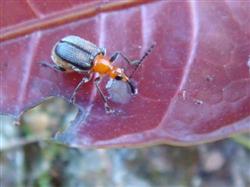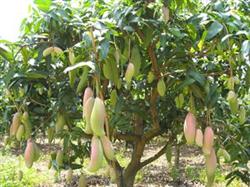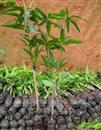How to control the weevil disease of mango

1. Mango leaf-cut weevil is widely distributed, adults feed on mango tender leaves, causing the leaves to dry up, or females lay eggs on the tender leaves and bite off the tender leaves from the base, affecting plant growth. Control methods: during the tender shoot growth period, ① picked up the fallen leaves that were bitten off every 3 days, dried and burned, and killed the larvae; ② sprayed once every 7 days during the tender shoot growth period, using 1500 times of 40% dimethoate EC, 1000 times of 90% trichlorfon, 500 times of 2.5% dimethoate and 2.5% of enemy killing 2004000 times. two。 Fruit mango weevil and pulp mango weevil the former is a small beetle, about 7 mm long, black. The larvae eat mango seeds and affect the fruit quality; the flesh mango weevil is a small yellowish-brown beetle smaller than the fruit mango weevil, whose larvae eat the flesh, form tunnels and are filled with insect dung, making the fruit inedible. These two kinds of insects mainly occur in Yunnan, Vietnam, Cambodia and Indonesia and belong to quarantine objects. However, it is reported that this insect has been found in the border area between Guangxi and Yunnan in recent years. As the damage of these two kinds of insects is serious, but they only occur in local areas, quarantine must be strengthened to prevent them from expanding to the new area. In recent years, it is dangerous to import mangoes from Vietnam in large quantities without quarantine. Control methods: ① strictly quarantine system in areas where the pest has not been found, strictly prevent expansion in new areas; ② does a good job in orchard hygiene in pest-infested areas, pick up fallen fruits in time, and concentrate on poisoning; ③ autumn and winter combined with clear garden weeds, fine ploughing, removal of overwintering pests in soil cracks During the young fruit stage of 30-45 days after flowering, ④ sprayed the crown with the mixture of dimethoate, trichlorfon and water 1-1-1-5, once every 7-10 days, for 3 times in a row. Click to get more mango planting techniques click to get more fruit planting techniques
- Prev

How to manage the mango orchard?
To strengthen the comprehensive management of mango orchard is to achieve the goal of high yield, stable yield, high quality and improve economic benefit by promoting the robust growth of the tree. Specifically, we should start from the following aspects: first, soil farming should be fine. To ensure that the surface growth layer of good soil aggregate structure, taboo soil consolidation, protection.
- Next

How to cultivate mango grafted seedlings
1. Scion selection: the scion is collected from the improved variety mother garden or adult mother tree. The mother plant requires pure variety, high yield, stable yield, high quality and no quarantine diseases and insect pests. All nurseries with suitable conditions should have ear picking nurseries, which are specially used for ear picking and ear grafting. Select branches for the crown periphery to the sun, strong growth, full buds, disease-free.
Related
- Moge, come on! The staff of the peasant association in the producing area of cantaloupe were frightened when the crowd gathered.
- Causes and Solutions of low Fruit setting rate of Apple
- Symptoms and control measures of passion fruit virus disease
- Fruit growing lesson: how do apple orchards keep high yields?
- Can you build orchards in the mountains? What are the pros and cons?
- How to manage the coloring period of Crisson grape?
- This paper introduces the processing technology of two kinds of fig products.
- How much is a month for retired teachers in rural areas by 2020?
- How can strawberry planting increase sugar content? We should pay attention to management in many aspects.
- What are the cultivation techniques on how to improve the yield of golden fruit?

